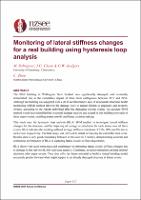Monitoring of lateral stiffness changes for a real building using hysteresis loop analysis

Download
Date
2021-04-14Authors
Rabiepour, Mohammad
Zhou, Cong
Chase, Geoff
Rodgers, Geoffrey
Metadata
Show full item recordAbstract
The BNZ building in Wellington, New Zealand was significantly damaged, and eventually demolished, due to the cumulative impact of three main earthquakes between 2013 and 2016. Although the building was equipped with a set of accelerometers, lack of an accurate structural health monitoring (SHM) method allowed the damage level to remain hidden to engineers and property owners, according to the reports published after the damaging seismic events. An accurate SHM method would have identified the structural damage location and extend in this building over each of three major events, enabling proper retrofit and better decision making.
This study uses the hysteresis loop analysis (HLA) SHM method to investigate lateral stiffness changes for this structure, and the trajectory of damage accumulation for each storey over all three events. HLA indicates the building suffered average stiffness reductions of 21%, 20% and 8% due to each event, respectively. The first storey lost ~67% of its initial stiffness by the end of the third event. Results show a very good consistency between events over all 5 storeys, demonstrating accurate and continuous performance of HLA in capturing lateral elastic stiffness trajectories.
HLA shows very good robustness and consistency in estimating lateral elastic stiffness changes due to damage in this real-world, full-scale case analysis. Consistent, accurate estimation can help optimal decisions after major events. They also offer the future potential to build a virtual building model accurately predict forward what might happen to an already damaged structure in future events.
